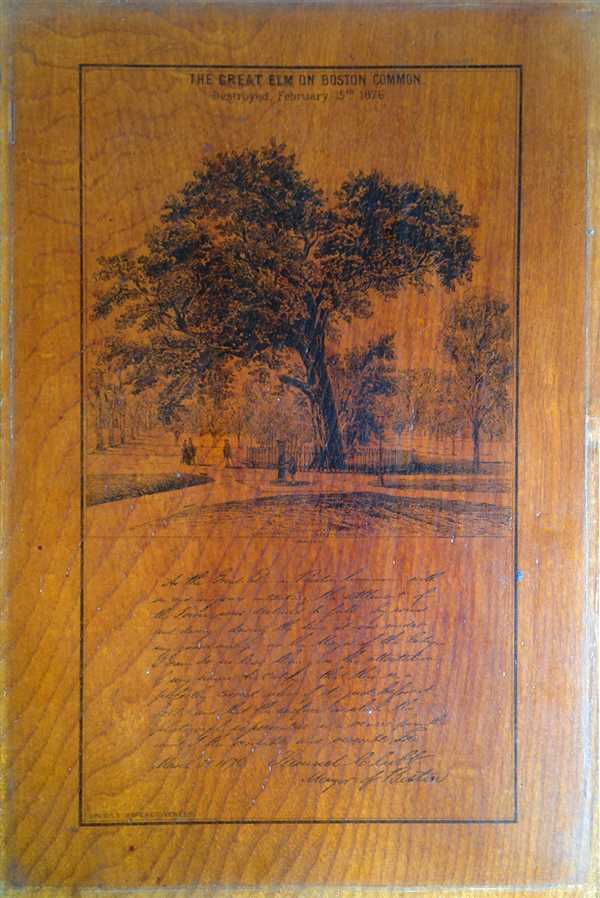This item has been sold, but you can get on the Waitlist to be notified if another example becomes available.
1876 Prang Veneer View of the Great Elm on Boston Common, printed on wood from the Great Elm
ElmBostonCommon-prang-1876
Title
1876 (dated) 13.5 x 9 in (34.29 x 22.86 cm)
Description
As the Great Elm on Boston Common, with an age in years outdating the settlement of the Town, was destined to fall, by wind and decay, during the time it was under my guardianship, as the Mayor of the City, I can do no less than give the attestation of my name to certify that this is a perfectly correct view of it, just before it fell, and that the surface on which the photograph is presented is a veneer from the wood of the veritable, and venerable, tree. March 31, 1876, Samuel Cobb, Mayor of Boston.. The Great Elm stood as an enduring symbol of Boston for over 200 years. By 1855, it was over 72 feet tall and 22 feet around at the base and was often referred to as ‘Boston’s Oldest Inhabitant’. Nathaniel B. Shurtleff’s Topographical and Historical Description of Boston includes an eight-page account of the Elm. Over time, the tree was damaged due to overuse and age. A storm in 1860 severely weakened and damaged the tree and another storm in 1876 eventually toppled the Great Elm. A chair carved from the wood now sits in the Rare Book Room of the Boston Public Library, The Mayor released a statement on the veneer of the tree, accompanied by Prang’s lithography, to celebrate it’s legacy to the community.
Today, visitors to the Boston Common can see the plaque commemorating the tree at its original site.
Cartographer
Louis Prang (March 12, 1824 - September 14, 1909) was a Boston based publisher of lithographs and chromolithographs active in the latter half of the 19th century. Prang was born in Breslau Germany where he studied printmaking and engraving from his father, a noted master of the calico process. Around 1850, Prang immigrated to the United States fearing political persecution in Germany after the failed Springtime of the Peoples Revolution, making him a 48er. In the United States, Prang partnered with another German Printmaker, Julius Mayer, establishing the short-lived Prang & Mayer firm. Ten years later, in 1860, Prang started his own chromolithography firm, L. Prang & Co. Prang quickly established himself as a publisher of post cards and other small prints, which were popular as gifts and collectibles. He was especially successful with mass-produced overviews of major battles in the U.S. Civil War, and his 'War Telegram Marking Map' was memorable for being sold with colored pencils, allowing buyers to track the movement of armies over time. Many consider him to be the "Father of the American Christmas Card". Prang also issued larger format chromolithographs of popular art and even printed his own magazine to the effect Prang's Chromo: A Journal of Popular Art. Through his magazines and limited edition printings, Prang was influential in establishing the popularity of the chromolithographic process in America. More by this mapmaker...

